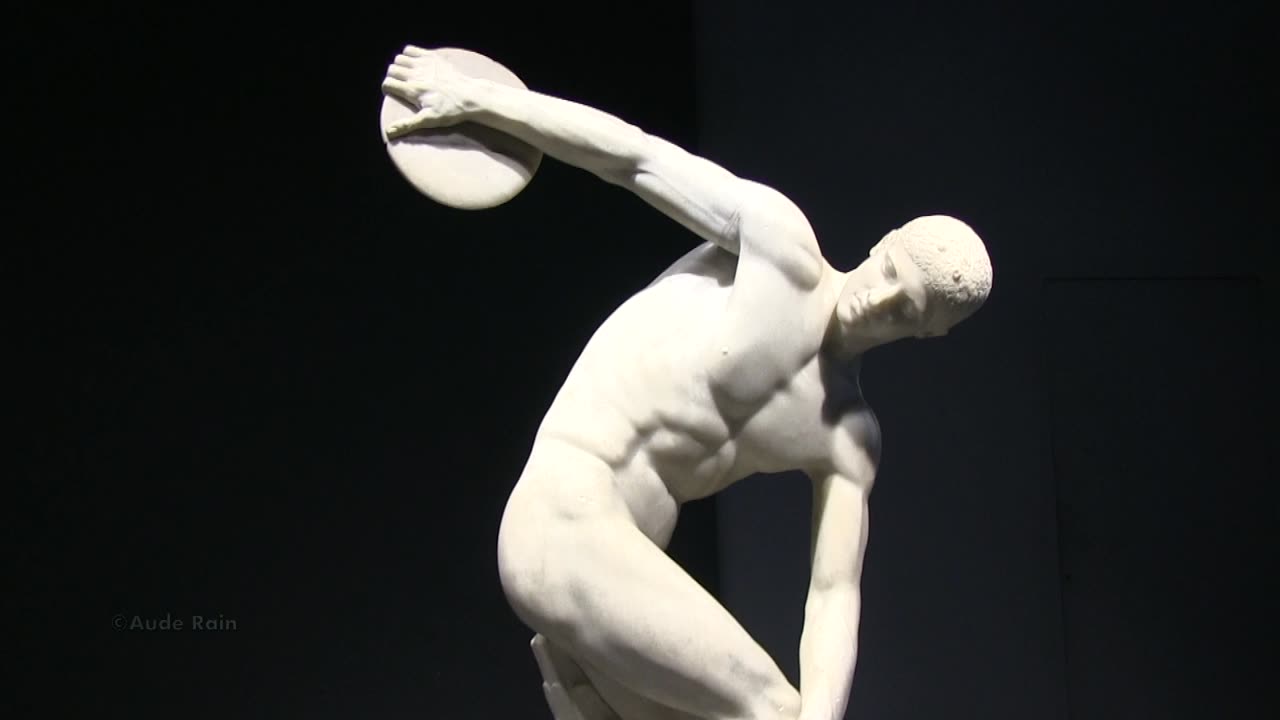Premium Only Content

Discobolus (Discus Thrower) | Palazzo Massimo alle Terme | Rome
"Two copies of the mid-second century A.D. from a bronze original of the fifth-century sculptor Myron, much celebrated by the ancient writers as a fundamental work for the study of the athletic figure in motion.
Executed in the Antonine Age, because of its lack of tridimensionality it is considered one of the closest replicas to the original, generally dated from about 450 BC.
On the other hand, the Discobolus from Castel Porziano, unfortunately lacking the head, was found in 1906 among the remains of an Imperial villa in the estate of Castel Porziano.
It constitutes a more naturalistic and evolved version in comparison with the Lancelloti copy, which perhaps was executed in the age of Hadrian, as suggested by the support in the shape of a palm trunk and by the shape of the plinth." archeoroma.beniculturali.it/en/national-roman-museum-palazzo-massimo-alle-terme/sculptures/discobolus-discus-thrower
‘In 1936, as part of the celebrations associated with the organisation of the Olympic Games, an exhibition, ‘Sports of the Greeks’, showed several representations of the Discobolus in Berlin, including the small bronze statuette in the Münich Glyptothek. Greek statuary and the perfect bodies it represented fascinated Nazi ideologists. The work appeared in Leni Riefenstahl's film Olympia, released in 1938 and shown to Hitler for his birthday on 20 April 1938: in a fade-out, the statue is transformed into a flesh-and-blood athlete played by Erwin Huber. Hitler was so taken with the Discobol that he bought it in 1938. With Mussolini's agreement, he bought the Discobol from the Lancellotti family for five million Reichsmarks, a sum equivalent to $327,000 at the time. The Führer cited it in a speech he gave on 9 July 1938, in which he presented it as a gift to the German people. This Roman copy from the imperial period was exhibited in a museum in Munich and was intended to serve as a model of beauty to be attained, and even surpassed, by the German people. After the war, the United States put pressure on the statue to return to Rome. German academics argued that it had been purchased legally, but the American military government and the Italian intelligentsia worked together to have it returned to Italy, not to the Lancellotti family, but to the national museum. This was done in November 1948." wikipedia
-
 LIVE
LIVE
Badlands Media
10 hours agoDevolution Power Hour Ep. 374
14,190 watching -
 2:00:38
2:00:38
Inverted World Live
4 hours agoWhite House Boosts the AI Revolution | Ep. 79
31.7K4 -
 1:08:21
1:08:21
Iggy Azalea
2 hours ago $0.22 earnedPlaying blackjack and catching up with everyone.
21.1K1 -
 10:23:56
10:23:56
Dr Disrespect
13 hours ago🔴LIVE - DR DISRESPECT - 10 WINS CHALLENGE - BIG ANNOUNCEMENT AT 12PM PT
141K20 -
 1:35:15
1:35:15
Man in America
7 hours ago🚨 ALERT: Hospitals in the U.S. Are KILLING Patients… for Their Organs!
40K7 -
 DVR
DVR
I_Came_With_Fire_Podcast
11 hours agoObama's Treason, Trade War: Season Infinity, and Hunter's Pipe Dream
13.3K -
 2:52:51
2:52:51
TimcastIRL
4 hours agoObama Referred To DOJ For TREASON, Criminal Investigation, CIVIL WAR!! | Timcast IRL
205K106 -
 9:43:32
9:43:32
RalliedLIVE
11 hours ago $5.56 earned10 WINS WITH THE SHOTTY BOYS
93.6K3 -
 1:35:43
1:35:43
Badlands Media
15 hours agoAltered State S3 Ep. 38: Biolabs, Bitcoin & the Epstein Data Vault
52.5K10 -
 LIVE
LIVE
SpartakusLIVE
3 hours agoLAST Stream Until NEXT WEEK || Going to Florida to hang out w/ a SPECIAL Gaming Buddy
291 watching